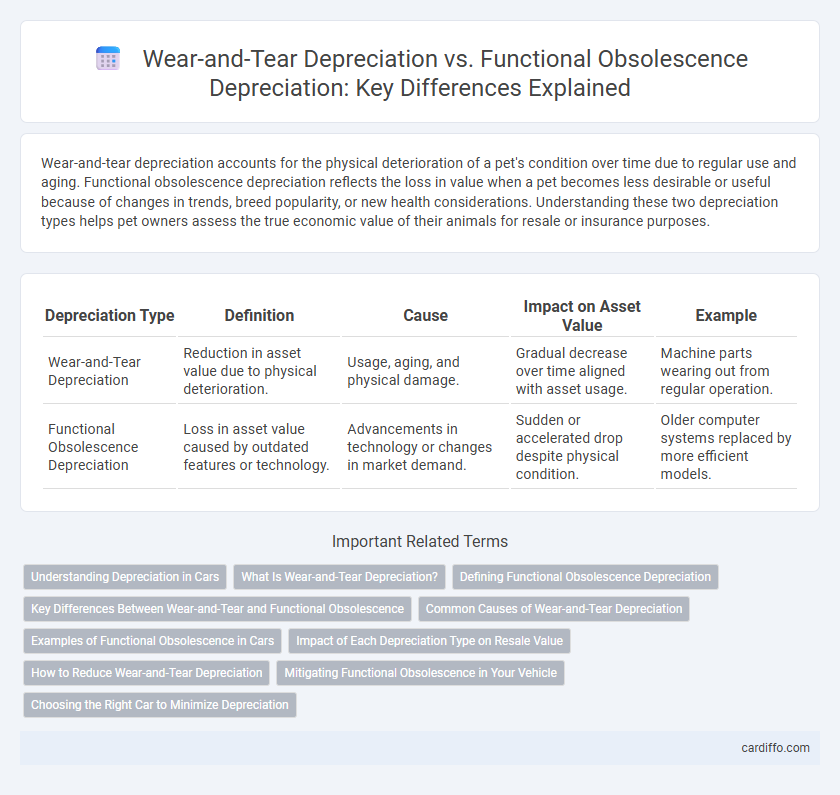Wear-and-tear depreciation accounts for the physical deterioration of a pet's condition over time due to regular use and aging. Functional obsolescence depreciation reflects the loss in value when a pet becomes less desirable or useful because of changes in trends, breed popularity, or new health considerations. Understanding these two depreciation types helps pet owners assess the true economic value of their animals for resale or insurance purposes.
Table of Comparison
| Depreciation Type | Definition | Cause | Impact on Asset Value | Example |
|---|---|---|---|---|
| Wear-and-Tear Depreciation | Reduction in asset value due to physical deterioration. | Usage, aging, and physical damage. | Gradual decrease over time aligned with asset usage. | Machine parts wearing out from regular operation. |
| Functional Obsolescence Depreciation | Loss in asset value caused by outdated features or technology. | Advancements in technology or changes in market demand. | Sudden or accelerated drop despite physical condition. | Older computer systems replaced by more efficient models. |
Understanding Depreciation in Cars
Wear-and-tear depreciation in cars results from physical deterioration due to regular use, affecting components like tires, brakes, and the engine over time. Functional obsolescence depreciation occurs when a vehicle becomes outdated because of advancements in technology or changes in consumer preferences, such as the introduction of electric vehicles or enhanced safety features. Differentiating these helps owners and appraisers accurately assess a car's market value and maintenance needs.
What Is Wear-and-Tear Depreciation?
Wear-and-tear depreciation refers to the loss in value of an asset caused by physical deterioration due to regular use and aging. It accounts for the gradual decline in functionality and efficiency as components wear out or break down over time. This type of depreciation is distinct from functional obsolescence, which arises from outdated technology or design rather than physical damage.
Defining Functional Obsolescence Depreciation
Functional obsolescence depreciation occurs when an asset loses value due to outdated design, features, or technology, reducing its utility compared to newer models. Unlike wear-and-tear depreciation, which results from physical deterioration, functional obsolescence affects assets that remain physically intact but fall behind modern standards. This form of depreciation is critical in industries where technological advancement rapidly diminishes the asset's market value and operational relevance.
Key Differences Between Wear-and-Tear and Functional Obsolescence
Wear-and-tear depreciation arises from physical deterioration due to regular use, affecting an asset's operational efficiency and market value over time. Functional obsolescence depreciation occurs when an asset loses value because of outdated features, design flaws, or technological advancements, rendering it less useful despite its physical condition. The key difference lies in wear-and-tear focusing on physical decline, while functional obsolescence emphasizes reduced utility caused by external changes or innovations.
Common Causes of Wear-and-Tear Depreciation
Common causes of wear-and-tear depreciation include physical deterioration from regular use, exposure to environmental elements such as moisture and temperature fluctuations, and mechanical breakdowns due to aging components. This type of depreciation reflects the gradual loss of asset value resulting from everyday operation, leading to reduced efficiency and increased maintenance costs. Understanding these factors is essential for accurately estimating the remaining useful life and appropriate depreciation expenses of tangible assets.
Examples of Functional Obsolescence in Cars
Functional obsolescence in cars occurs when a vehicle becomes less valuable due to design flaws or outdated features, such as the lack of modern safety technology or inefficient fuel systems. Examples include older models without advanced driver-assistance systems (ADAS) or vehicles with manual transmissions that are less desirable compared to automatic options. This type of depreciation reduces a car's market value independently of physical wear and tear, reflecting changes in consumer preferences and technological advancements.
Impact of Each Depreciation Type on Resale Value
Wear-and-tear depreciation reduces resale value by reflecting the physical deterioration of an asset, making it less reliable and less appealing to buyers. Functional obsolescence depreciation impacts resale value by highlighting outdated features or inefficiencies, which decrease usability despite the asset's physical condition. Assets suffering from functional obsolescence often experience sharper declines in market value as technology and design demands evolve.
How to Reduce Wear-and-Tear Depreciation
Regular maintenance and timely repairs significantly reduce wear-and-tear depreciation by preserving the physical condition of an asset. Using high-quality materials and implementing proper usage protocols minimizes the impact of continuous use. Investing in protective measures such as climate control and load management further extends the asset's lifespan and value.
Mitigating Functional Obsolescence in Your Vehicle
Mitigating functional obsolescence in your vehicle requires proactive upgrades to essential components such as infotainment systems, safety features, and fuel efficiency technologies. Regular software updates and timely installation of advanced driver-assistance systems (ADAS) can preserve the vehicle's market value and decrease accelerated functional depreciation. Maintaining compatibility with evolving environmental and regulatory standards also reduces the risk of functional obsolescence impacting resale price.
Choosing the Right Car to Minimize Depreciation
Wear-and-tear depreciation reflects the physical deterioration of a car due to regular use, while functional obsolescence depreciation results from outdated features or technology making the vehicle less desirable. Choosing a car with durable materials and modern technology can minimize both types of depreciation, preserving resale value. Prioritizing models with strong reliability ratings and up-to-date safety features helps reduce overall depreciation costs.
Wear-and-Tear Depreciation vs Functional Obsolescence Depreciation Infographic

 cardiffo.com
cardiffo.com